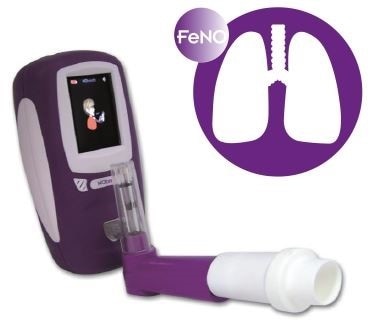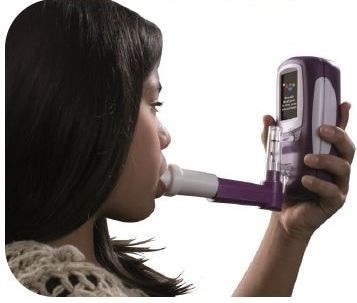Sponsored Content by NObreathMar 20 2018
Asthma is a chronic disease associated with inflammation in the airways. Affecting approximately 300 million individuals across the globe, it is the most wide-spread non-communicable condition in the world.7

Image credit: Bedfont Scientific
Asthma can be characterized by recurrent attacks of wheezing, breathlessness and coughing, and differs in frequency and severity from one person to next.
When an asthma attack occurs, the bronchial tubes become inflamed restricting the airways and eventually reducing the flow of air into and out of the lungs.

Image credit: Bedfont Scientific
Fractional exhaled nitric oxide
The human body produces nitric oxide (NO) to help fight inflammation, and when the airway becomes inflamed NO is generated in the lungs and then exhaled on the breath.
Inflammation of the airways is a core process in various lung diseases, including asthma1. The ability to detect airway inflammation and monitori a patient’s response to therapy is considered the benchmark in the management of respiratory conditions.

Image credit: Bedfont Scientific
In order to help differentiate between non-allergic and allergic asthma, FeNO can be utilized as a non-invasive biomarker of airway inflammation. It can also be used to distinguish between asthma and other respiratory diseases. The use of FeNO measurements to assess airway inflammation in asthma indicates a major development in respiratory medicine2, but has hitherto been a costly test to apply in day-to-day practice.

Image credit: Bedfont Scientific
Advantages of performing FeNO tests:
- Fast, easy, and non-invasive to perform2
- Reveals a patient’s response to therapy, making it possible to prescribe the right medication and make safer and monitored adjustments
- Demonstrates the patient’s adherence to medication
- Shown to be better than most of the traditional tests of lung function, for example spirometry and peak flow recording2
- Helps in detecting patients who do or do not need continuous treatment3
- Helps in distinguishing between non-allergic and allergic asthma4
How to use FeNO testing in initial assessments of asthma care
For asthma diagnosis, FeNO testing can be utilized with individuals who exhibit symptoms in their initial assessment. In order to confirm asthma, it is important to complete FeNO measurements together with other types of diagnostic tests, for example spirometry.5
Management and control
Asthma patients who are symptomatic, in spite of using prescribed medication, can benefit from regular FeNO measurements in asthma management. When FeNO levels are interpreted correctly, therapy and treatment can be changed accordingly. If FeNO measurements are used on regular basis, they can help prevent or reduce attacks and exacerbations.6

Image credit: Bedfont Scientific
References
- Shelhamer JH, Levine SJ, Wu T, Jacoby DB, Kaliner MA, Rennard SI. NIH conference: airway inflammation. Ann Intern Med 1995;123:288-04.
- Correlation of Exhaled Nitric Oxide, Spirometry and Asthma Symptoms: Journal of Asthma: Vol 42, No 10 [Internet]. Tandfonline.com. 2017 [cited 15 March 2017]. Available from: http://www.tandfonline.com/doi/abs/10.1080/02770900500371344
- Andrew D. Smith, Jan O. Cowan, Sue Filsell, Chris MacLachlan, Gabrielle Monti-Sheehan, Pamela Jackson and D. Robin Taylor. Diagnosing Asthma:
- Comparisons between Exhaled Nitric Oxide Measurements and Conventional Tests. Am J Respir Crit Care Med Vol 169. pp 473-478, 2004.
- National Institute for Health and Clinical Excellence (2017) Asthma: diagnosis and monitoring of asthma in adults, children and young people. NICE guideline (NG80)
- Harkins M. Exhaled Nitric Oxide Predicts Asthma Exacerbation [Internet]. Taylor & Francis. 2017 [cited 21 September 2017]. Available from: http://www.tandfonline.com/doi/abs/10.1081/JAS-120033990
- SS B. The global burden of asthma. - PubMed - NCBI [Internet]. Ncbi.nlm.nih.gov. 2017 [cited 10 October 2017]. Available from: https://www.ncbi.nlm.nih.gov/pubmed/16840363
About Bedfont Scientific
Bedfont® Scientific has specialised in the design and manufacture of exhaled breath and gas monitoring instruments since 1976.
For medical gas monitoring, their Medi-Gas Check medical pipeline testing range verifies not only the quantity but also quality of gas administered to patients.
Bedfont's breath analysers include carbon monoxide (CO) monitors such as the Smokerlyzer®, used for smoking cessation, and the ToxCO®, used by emergency services, to diagnose CO poisoning.
The NObreath® FeNO monitor provides accurate analysis of airway inflammation for the control of asthma, and the Gastrolyzer® range aids in the detection of gastrointestinal disorders and food intolerances. Quick and non-invasive, breath analysis is the new blood test.
Sponsored Content Policy: News-Medical.net publishes articles and related content that may be derived from sources where we have existing commercial relationships, provided such content adds value to the core editorial ethos of News-Medical.Net which is to educate and inform site visitors interested in medical research, science, medical devices and treatments.